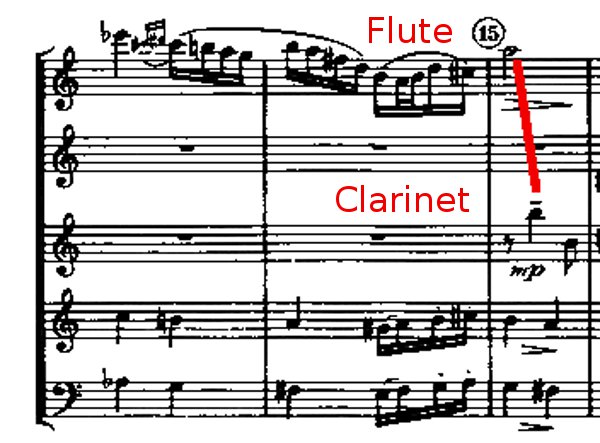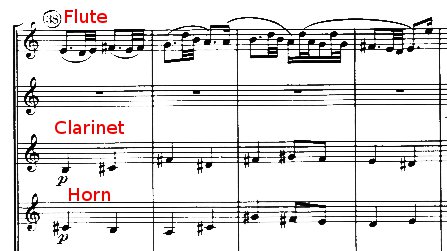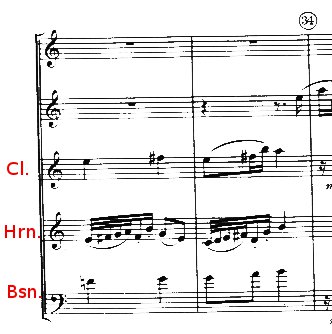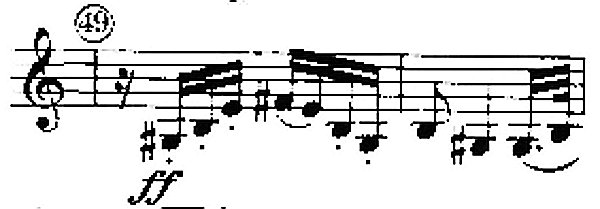<Music: Performance by Quintigre from the sixth movement.>
Hello, my name is Jim Logan and I serve as the clarinet professor here at Towson University as well as assistant principal clarinetist of the United States Navy Band in Washington, D.C.
I am going to touch on a number of aspects of playing the first movement of Milhaud's Quintet that can be applied to many facets of your playing. To begin with is a problem that I see frequently in a student or even a professional, which is making a clean attack or in this case a clean entrance. For the clarinet it is in measure 15. It is an A concert, a B written above the staff.

In order to prepare for that entrance, you really need to get the air, embouchure, and tongue, everything lined up, in place for about a beat before the actual entrance. I am all about playing percentages. You have a much better chance at hitting that entrance, ten times out of ten, cleanly by preparing everything as much as possible. At the time the flute plays the downbeat, which is also a concert A, that you need to match, you simply release the tongue off of the reed. The air should already be moving through the instrument and the embouchure is already formed on the mouthpiece. So the only thing that happens to make that entrance is that the tongue is released off of the reed.
So I am going to demonstrate both ways. The one way of throwing everything together at the last second and praying for the best, that everything will happen wonderfully. So it would look like this.
<Demonstration>
That entrance was OK. There is a lot of danger there: of the tongue hitting too hard, or of it popping, or there being a "chirp," or what have you. So what I would strongly suggest is that beginning as early as beat 2 of measure 14 the embouchure, air, and tongue is there so that when the time comes you simply release the tip of the tongue off of the tip of the reed. Then you will have the first note which will hopefully go like this.
<Demonstration>
<Music: Quintigre performing the passage>
So, next we are going to talk about rhythm a little bit in the very next measure, measure 16.

There is a dotted eighth and 32nd note rhythm there. This is all about subdivision, subdivision, subdivision. This is always very important. I am going to discuss the importance of playing that subdivision as 16th notes, for example, as a practice method.
<Demonstration with tongued 16th notes>
And then following it with what is actually written:
<Demonstration as written>
So there is no guess work involved. Think 16th notes all the way through that.
Next are syncopations. This is a royal type of majestic march. We have some syncopations, for example, in measures 26 and 27 and in various places.

It would be out of character in this piece to play them long. you wouldn't want:
<Demonstration with long length>
Something with a little more separation and forward movement:
<Demonstration in correct style>
Generally speaking with syncopations it is very easy for the time to pull back a little bit, which is all the more reason we want to have a little bit of space between the notes there.
<Music: Quintigre performing the passage>
One other thing I would like to touch on is always being aware of where the solo line is, who is playing that line, and what range they are in. This is so that you are not just soft, but rather you are under [the solo]. Sometimes you can be too soft, it depends on how loud that particular line is written at the time.

For example, in measure 38 the flute has the solo line there. It is very important that you observe the piano at measure 38 and realize that those notes when unsupported in the low register on the clarinet can be quite high. So remember to keep the pitch down. Again, stay below the flute.

Back at measure 32 the clarinet line supports the horn who is playing out a bit stronger. So you are still accompanying the solo but you are a good bit louder than you would be at measure 38 because of how that line is written for the flute.
<Music: Quintigre performing the two passages>
In measure 49 we have some staccato 16th notes written in the low register.

One concern I have with this is that we remember to exagerate the staccato notes. Again this is a march so we wouldn't want anything legato. Because of the range it is written in it would be very easy for the 16th staccato notes to come out too long. Which would be:
<Demonstration with notes too long>
There is some separation there so technically it is staccato. But given the register you would want to exagerate that a bit and get more of:
<Demonstration with proper lengths>
<Music: Quintigre performing the passage>
Finally to conclude my segment I would like to talk about phrasing briefly. I mentioned that the clarinet accompanies the flute in measure 38. It is important that you agree on where to breathe. I would say that you should breathe after the first four bars in measure 41 and then after the dotted quarter note of measure 44.

You may chose to not do that, but it is important make that decision together so that one of you is not breathing while another one is. This is so it sounds like you are playing together as an ensemble, which is always very important.
Thank you very much.
<Music: Performance by Quintigre from the sixth movement.>
